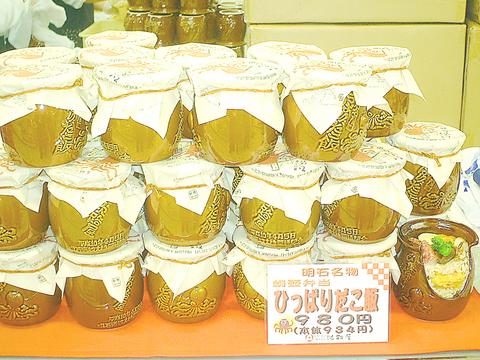A combination of pork chops, cabbage and rice gave Taiwan's often-absent and much-maligned presence on the international stage a flavorsome boost last week, when Taiwan Railway's classic pork chop and vegetable lunchbox (台灣懷舊排骨菜飯便當) became the first international participant to take part in an annual lunchbox show in Tokyo.
Organized by the Japanese hotel and department store chain, Keiouko (

PHOTO COURTESY OF TAIWAN RAILWAY
Attracting huge crowds, the lunchboxes on show are not your run-of-the-mill Styrofoam-packaged variety. Not only do railway stations and mass-transportation companies from across Japan tempt the crowds with regional delicacies, but fancy packaging is also an important aspect of the show.

PHOTO COURTESY OF TAIWAN RAILWAY
Companies use ornately handcrafted bamboo boxes and clay pots looking more like vases than something you'd put your lunch in, to vie for custom, out-sell their rivals and become, quite literally the hottest box in town.
Initially invited to participate in last year's event, Taiwan Railway's Catering Service Department (
While not participating in the event, Chen Ching-piao (
"It being our anniversary year, we were inundated with calls from people who remembered the railway lunchboxes of the 1950s," recalled the catering manager.
"So we decided to produce a limited edition of 1,000, package them in a commemorative aluminum box and sell them on Taiwan Railway's anniversary (鐵路節) on June 8."
All of which proved rather more popular than initially expected. Within three-hours of the railway company's announcing it had produced a limited edition bien dang with fancy packaging and filled with the taste of yesteryear, the company had been inundated with phone calls from people eager to purchase a retro-lunchbox.
And so, packaged in a fancy aluminum container and comprising rice, a pork chop, cabbage and an egg, the Taiwan Railway representative lunchbox was born.
According to Chen, its use of oil from the cooked pork, locally produced cabbage and the presence of dried shrimps in the rice ensured that the lunchbox met with the highest standards and possessed a truly Taiwanese flavor.
With the recipe for success secured, Taiwan Railway began preparing for the event earlier this month. Filling 7,500 aluminum lunch boxes with its special classic pork chop and vegetable meal in readiness for the event that kicked off last Thursday; a day that took Chen's breath away.
"I'd heard the event was popular, but there were huge crowds. You couldn't use the stairwell as a line of people packed it from the venue's basement-one level to the seventh floor where the show was being held," continued Chen.
Made with relatively inexpensive ingredients, Taiwan's entrant in Japan was far from cheap. Priced at the equivalent of NT$450, Taiwan's bien dang was in fact the most expensive lunchbox at this year's show -- its Japanese counterparts averaged NT$350.
Not that this deterred hoards of hungry Japanese from swamping the Taiwan Railway's bien dang stall within minutes of the event's official opening. It did come as somewhat of a surprise for Chen and his fellow Taiwan Railway representatives, however. While expecting some interest they were shocked, yet proud, of what actually happened.
Within 15 minutes of the show opening at 10am on Jan. 9, all 400 Taiwan Railway lunchboxes prepared for that day had been sold.
This was repeated the following day, when all 500 lunchboxes sold out within minutes of the show's opening its doors. And day three was no different, with a total of 700 Taiwan Railway bien dangs being sold long before noon.
"We obviously didn't expect to sell out all 400 that quickly on the first day. And when we sold 500 on the second day and even more on the third day I was amazed," said Chen. "I think the secret of our success lays in the fact that the [lunchbox] is simple yet flavorsome."
The lunchbox has proven so popular that Japanese news reports have been filled with interviews with exasperated visitors who had arrived at the event only to discover that Taiwan's lunchbox had sold out hours before.
Missing the opportunity to sample Taiwan's classic pork chop and vegetable lunchbox, one elderly female Tokyo resident was quoted as explaining that she'd be "getting extra early the following day so as to be able to dine on a Taiwan Railway bien dang."
While Tokyo residents looking for that Taiwanese taste of yesteryear have to set their alarm clocks for ungodly hours, locals have it a bit easier. Due to the lunchbox's runaway success in Japan, Taiwan Railway has launched a special Year End Party Lunchbox (
Costing NT$300, however, Taiwan Railway's lunchbox probably won't become a participant in the ongoing "bien dang wars" being fought out between the nation's connivance stores and more recently McDonalds.

Last week, the the National Immigration Agency (NIA) told the legislature that more than 10,000 naturalized Taiwanese citizens from the People’s Republic of China (PRC) risked having their citizenship revoked if they failed to provide proof that they had renounced their Chinese household registration within the next three months. Renunciation is required under the Act Governing Relations Between the People of the Taiwan Area and the Mainland Area (臺灣地區與大陸地區人民關係條例), as amended in 2004, though it was only a legal requirement after 2000. Prior to that, it had been only an administrative requirement since the Nationality Act (國籍法) was established in

Three big changes have transformed the landscape of Taiwan’s local patronage factions: Increasing Democratic Progressive Party (DPP) involvement, rising new factions and the Chinese Nationalist Party’s (KMT) significantly weakened control. GREEN FACTIONS It is said that “south of the Zhuoshui River (濁水溪), there is no blue-green divide,” meaning that from Yunlin County south there is no difference between KMT and DPP politicians. This is not always true, but there is more than a grain of truth to it. Traditionally, DPP factions are viewed as national entities, with their primary function to secure plum positions in the party and government. This is not unusual

The other day, a friend decided to playfully name our individual roles within the group: planner, emotional support, and so on. I was the fault-finder — or, as she put it, “the grumpy teenager” — who points out problems, but doesn’t suggest alternatives. She was only kidding around, but she struck at an insecurity I have: that I’m unacceptably, intolerably negative. My first instinct is to stress-test ideas for potential flaws. This critical tendency serves me well professionally, and feels true to who I am. If I don’t enjoy a film, for example, I don’t swallow my opinion. But I sometimes worry

US President Donald Trump’s bid to take back control of the Panama Canal has put his counterpart Jose Raul Mulino in a difficult position and revived fears in the Central American country that US military bases will return. After Trump vowed to reclaim the interoceanic waterway from Chinese influence, US Defense Secretary Pete Hegseth signed an agreement with the Mulino administration last week for the US to deploy troops in areas adjacent to the canal. For more than two decades, after handing over control of the strategically vital waterway to Panama in 1999 and dismantling the bases that protected it, Washington has